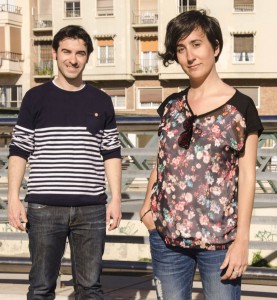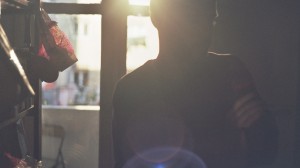(NO TRANSLATION IN ENGLISH AVAILABLE)
Entrevista a Delia Márquez i Pablo Díaz, directors de Lugares comunes, el curtmetratge guanyador de l’edició d’enguany del Premi Gas Natural Fenosa.
El curt es podrà veure a la sessió inaugural de Gandules’14 el dia 5 d’agost.
 «La idea ens va venir com un flaix», expliquen els directors del curt guanyador de l’edició d’enguany del premi Gas Natural Fenosa, Lugares comunes. Delia Márquez (Màlaga, 1987) i Pablo Díaz (Màlaga, 1979) havien viatjat a Düsseldorf (Alemanya) per visitar una amiga infermera que treballa allà des de fa uns anys. Una visita turística, una parada d’autobús i uns quants minuts per pensar van ser el germen d’aquest curtmetratge, també guardonat a l’Acadèmia del Cine d’Espanya amb el segon premi de RNE.
«La idea ens va venir com un flaix», expliquen els directors del curt guanyador de l’edició d’enguany del premi Gas Natural Fenosa, Lugares comunes. Delia Márquez (Màlaga, 1987) i Pablo Díaz (Màlaga, 1979) havien viatjat a Düsseldorf (Alemanya) per visitar una amiga infermera que treballa allà des de fa uns anys. Una visita turística, una parada d’autobús i uns quants minuts per pensar van ser el germen d’aquest curtmetratge, també guardonat a l’Acadèmia del Cine d’Espanya amb el segon premi de RNE.
Pablo: Pràcticament tot el guió, encara que després canviéssim coses, se’ns va ocórrer a la parada d’un autobús…
El curt, un retrat intimista i colpidor de com és la vida «fora de casa» per motius laborals, parla de la distància, l’enyorança i el procés d’adaptació d’una jove malaguenya a la gèlida Alemanya. Pablo ha estat l’encarregat del guió, que en aquesta peça s’articula a partir d’una veu en off, tendra i simpàtica, amb accent andalús, de l’actriu Virginia Muñoz. La Delia és la part visual, s’ha dedicat a enregistrar i a improvisar amb la Virginia Valle (l’altra Virginia, protagonista física de la història, infermera a la vida real) des de finals de gener fins a principis de febrer.
Delia: Primer vam definir la idea, el Pablo va fer el primer esborrany, que em va servir a mi com a guia de gravació de cadascun dels plans. En aquest primer esborrany es preveien escenes que al final ens vam veure obligats a eliminar perquè eren molt complexes.
–I cap a mitjans de febrer tornes aquí.
Delia: A Màlaga, amb un munt de material gravat, és el moment de donar forma a tot el material i adaptar-lo al guió. La música és del compositor gallec José María Martínez, que va contactar amb mi fa temps, i revisant els temes que tenia compostos, vam decidir quedar-nos amb el guitarreo que caracteritza i dóna ritme a la història. Amb la carta tancada, les pautes, la veu i la música, comencem a muntar, encaixar les peces del puzle.
–La dedicatòria final del curt és tota una declaració d’intencions («A todos los que se fueron. Ayer y hoy») i subratlleu «y sobre todo a y para Virginia Valle». Virginia Valle, la mateixa protagonista, la infermera, no?
Pablo: Indubtablement, és la persona que ens va motivar per fer això. És una amiga en comú que tenim i que viu a Düsseldorf des de fa quasi dos anys. L’estimem molt i la trobem a faltar per Màlaga.
Delia: Ella és infermera, i al curtmetratge vam haver de simular que treballava en una farmàcia (Apotheke en alemany) perquè no era possible gravar-la a l’hospital. Des del principi va tenir molta disponibilitat i va ser molt fàcil. Com que ella no és actriu, el 90% del curt és improvisació i el 10% restant està una mica planificat, com l’escena de llançar pedres a l’aigua o fer veure que estudia alemany.
–I l’escena del plat de migas?
Delia: En aquesta escena ens ho vam passar molt bé, perquè era el primer cop que la Virginia preparava unes migas!
Pablo: Jo no hi era, però m’hauria encantat tastar aquelles migas.
–I alguna altra escena que recordeu especialment?
Delia: Per gravar les escenes de l’avió que apareixen al principi, vam haver d’anar a la zona habilitada que hi ha a l’aeroport de Düsseldorf per veure enlairar-se i aterrar els avions (Flughafen besucherterrassen). Ens vam perdre en arribar i ja era de nit, així que vam haver de tornar un altre dia per poder gravar aquells plans.
–Els crèdits del curt també són molt especials.
Delia: Els crèdits estan basats en unes cartes reals que vam comprar en unes botiguetes allà a Düsseldorf, i realitzats per Javier Ramos. I el cartell, de Juan Antonio Mariscal, també ha sabut capturar l’essència del nostre curt i plasmar-la en una imatge.
–A més d’aquest curt, havíeu treballat mai junts?
Delia: Hem fet curts junts i separats. Jo vaig debutar amb el meu primer curt l’any 2011 (¿Cómo funciona un paracaídas?), el 2012 vaig fer La petite mort, i a partir d’aquí, juntament amb el Pablo, hem codirigit diferents curts, com Almohadas separadas, Casting Vitae, La técnica del mono i finalment Lugares comunes.
Pablo: Jo vaig realitzar curts fa anys en solitari, però ho vaig deixar una mica, i fa relativament poc que m’he ajuntat amb la Delia i l’equip d’ Agudeza Visual. Sempre estem pensant nous projectes i formem un bon equip, perquè som molt semblants a l’hora de treballar.
–I parlant de «ser fora de casa» (la temàtica del vostre últim curt), us ho plantegeu com a opció de futur?
Delia: Jo m’ho he plantejat però mai he arribat a bon port. De moment em quedo a Màlaga, amb molts projectes per fer.
Pablo: Jo tinc feina ara mateix i no ho necessito, però em sembla una opció molt bona, conèixer altres països, una altra cultura… La llàstima és fer-ho per necessitat, perquè pràcticament el teu país t’hi obliga. El missatge del curt és aquest: això que està passant ara mateix, ja va passar fa un temps, i hem d’evitar que això passi en un futur.
–I si et donessin l’oportunitat de cedir el teu curt perquè algun director en fes un remake, quin escolliries?
Pablo: Ens encantaria que Ken Loach, amb el seu punt de crítica social, dirigís Common Places, el remake. I ja posats a somiar, que Jamel Debbouzé fes d’immigrant àrab o Lupita Nyong’o d’immigrant kenyana, en tots dos casos a Londres.












